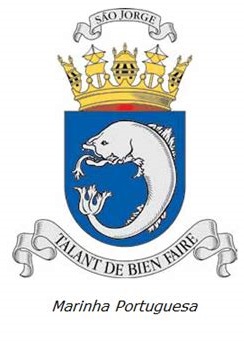The Brazilian Navy is the naval service branch of the Brazilian Armed Forces, responsible for conducting naval operations.

The Portuguese Navy, also known as the Portuguese War Navy or as the Portuguese Armada, is the navy of the Portuguese Armed Forces. Chartered in 1317 by King Dinis of Portugal, it is the oldest continuously serving navy in the world; in 2017, the Portuguese Navy commemorated the 700th anniversary of its official creation.

USS Hermitage (LSD-34) was a Thomaston-class dock landing ship of the United States Navy. She was named for The Hermitage, President Andrew Jackson's estate just outside Nashville, Tennessee.

The Portuguese Marine Corps is the special operations capable amphibious force of the Portuguese Navy.

The Combat Divers Group, abbreviated to GRUMEC, is a special operations and counterterrorism unit of the Brazilian Navy. Their main attributions include tasks such as reconnaissance, sabotage, hostage rescue and the elimination of targets of strategic value in maritime and riverine environments.

The Macaé class are a series of offshore patrol vessels being built for the Brazilian Navy by Arsenal de Marinha do Rio de Janeiro.

Almirante Tamandaré was a protected cruiser operated by the Brazilian Navy from 1897 to 1915. The construction of the cruiser was the result of Brazil's effort to develop a large steel ship, but the country had no experience with this type of ship, and the project resulted in an unreliable vessel.
In Portugal, the coast guard role is performed by several government agencies that, together, form the Maritime Authority System. The SAM includes the Portuguese Navy, the National Republican Guard (GNR), the Portuguese Air Force, the Civil Protection Authority, the National Medical Emergency Institute and the Criminal Investigation Police (PJ).

NAM Atlântico (A140) is an amphibious helicopter carrier and current flagship of the Brazilian Navy. Originally constructed in the United Kingdom for service with the Royal Navy as a landing platform helicopter, she was commissioned on 30 September 1998 as HMS Ocean, serving until being decommissioned on 27 March 2018, and then commissioned into service with Brazil the following June.

The Tamandaré class is a series of stealth frigates under construction for the Brazilian Navy since 2022, based on the MEKO family of warships. The project was developed by ThyssenKrupp Marine Systems in partnership with Embraer Defense and Security. As of 2024, four ships have been ordered, with other four planned as a second batch.

Liberal (F43) is a Niterói-class frigate of the Brazilian Navy. She was the fourth ship of her class ordered by the Brazilian Navy, on 20 September 1970. Liberal was launched on 7 February 1977, and was commissioned on 18 November 1978.
Ishikawajima do Brasil Estaleiros S.A commonly known as ISHIBRÁS was a shipbuilding company based in Rio de Janeiro, Brazil.

Tamandaré (F200) is the lead ship of the Tamandaré-class stealth frigates under construction for the Brazilian Navy.

West Sea Shipyard is a shipbuilding company of the Martifer Group, created in 2014 after the extinction of ENVC Shipyard. West Sea is dedicated to the construction of various types of ships, such as cruise ships and offshore patrol vessels. Since 2014 it has built more than 18 ships and repaired more than 50 ships, such as container ships, cankers, platform supply vessels, cargo ships, cruise ships, reefer ships and tugs.

Almirante Barroso was a protected cruiser operated by the Brazilian Navy between 1896 and 1931. It was the first Brazilian ship to have radio telegraphy. It represented Brazil in Argentina and Chile, in addition to other commissions. It was one of the government ships that faced the rebels in the Revolt of the Lash. It was decommissioned in 1931.

Benjamin Constant was a training ship that belonged to the Benjamin Constant-class of the Brazilian Navy. It was the first ship in the Navy to be named after Brazilian military officer Benjamin Constant and the first to be designed as a purpose-built training ship. Built in 1891 and launched in 1892, it had a 32-year long career, making dozens of instruction trips, and also securing Brazilian possession of Trindade Island. It had the nicknames "Garça Branca" and "Beijoca" (Smack). The ship was discharged from service on 22 February 1926. Its hull was destroyed by a fire in 1938. It was dismantled in 1949.

Almirante Barroso was a cruiser operated by the Imperial Brazilian Navy and later the Brazilian Navy from 1882 to 1893. Its name is a tribute to Brazilian admiral Francisco Manuel Barroso da Silva, the Baron of Amazonas. Its construction began in 1880 at the Rio de Janeiro Navy Arsenal, being launched into the sea in 1882. The ship was a demonstration of the potential of the Brazilian naval industry at the time, built with a combination of wood and steel.

Alexandrino Faria de Alencar was a Brazilian admiral and politician who served as Minister of the Navy several times during the First Brazilian Republic. During his many tenures as minister of the navy, Alencar carried out substantial reforms and modernizations in the Brazilian Navy.















